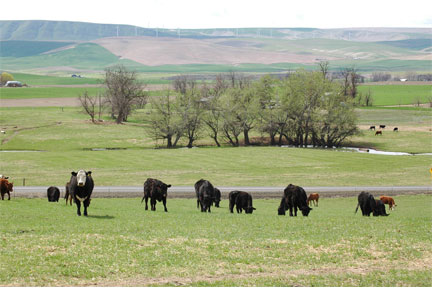
Agricultural News
Noble Research Shows Knowing Your Ranch Can Promote Accuracy in Estimating Grazeable Acres
Wed, 13 Nov 2019 16:28:17
 Estimating grazeable acreage as well as forage availability is vital to understanding the carrying capacity of a ranch and accurately setting a proper stocking rate. Mapping software, such as ArcGIS, is a tool commonly used to estimate grazeable acreage for cattle, with minimal technical expertise required. With this tool, managers can use aerial imagery of their ranch to determine grazeable acreage quickly by subtracting wooded areas and large water features from the total acreage of the ranch.
Estimating grazeable acreage as well as forage availability is vital to understanding the carrying capacity of a ranch and accurately setting a proper stocking rate. Mapping software, such as ArcGIS, is a tool commonly used to estimate grazeable acreage for cattle, with minimal technical expertise required. With this tool, managers can use aerial imagery of their ranch to determine grazeable acreage quickly by subtracting wooded areas and large water features from the total acreage of the ranch.
However, when using this technique, it is important to consider all the factors that may limit grazeability. What a manager describes as grazeable acres when evaluating an aerial image may not always be graze-worthy or even accessible to cattle on the ground, as a multi-year Noble grazing study has shown.
NOT ALL OPEN CANOPY ACRES ARE CREATED EQUAL.
Certain forages are more palatable than others, and some may not even be worthy of consideration as forage for cattle. Cattle are not likely to select threeawn a low seral grass stimulated by chronic overgrazing or poor, compacted soils until everything else is gone. Though class of cattle (cows or stockers) should also be considered, threeawn is low in preference and palatability for most cattle.
In a six-year study on Noble Research Institute's Oswalt Ranch, we equipped stockers with GPS collars to learn about stocker cattle grazing distribution, resource selection and effects on vegetation communities.
NOT ALL TOPOGRAPHY CAN BE CONSIDERED GRAZEABLE.
Limited utilization of quality forages on steep slopes can be attributed to the fact that cattle prefer to graze on flat areas or gentle slopes. In a GPS collar study cunducted by Texas A&M in the Davis Mountains of Texas, 95% of cow locations were located on slopes of 11% or less. Image 2 shows fixes from steers collared on Noble's Oswalt Ranch. Open breaks at the interface of shallow upland soils and sandy savanna were far less utilized by cattle because of the steep slopes.
WHAT APPEARS TO BE OPEN GRASSLAND IN AN AERIAL IMAGE IS NOT ALWAYS AVAILABLE TO CATTLE.
It pays to know your ranch. What appears to be open canopy grassland may be inaccessible to cattle because of brush encroachment. Technology is handy but no substitute for ground truth. On a first look at image 3, it seems strange that cattle did not use this open area more. However, inspection of the site from the tractor seat shows it would be tough for a rabbit to weave through the briars encroaching on this grassland. Where there's impenetrable brush with good grazing behind it, a manager can develop and maintain lanes or roads to increase accessibility and usage by cattle.
IMPOUNDMENTS CAN HELP DISTRIBUTE GRAZING PRESSURE.
Impoundments are also a nice rangeland feature, because with appropriate spacing they can help distribute grazing pressure and add to the landscape aesthetically and often recreationally. It is important to consider that areas located more than 1 mile from available water will receive less grazing pressure. Additionally, when using mapping tools to determine grazeable acres, managers may only cut out wooded areas, disregarding many water features. Ponds, of course, should not be considered grazeable.
The same can be said for roads. One mile of gravel road (8 feet wide) is 1 acre. In our study, roads showed cattle using the roads because of ease of walking, not because they were graze-worthy.
CONCLUSION
Using aerial imagery to identify acres suitable for grazing is a practical tool for most managers, but it is important to realize its limitations. Just like determining forage availability, the accuracy in assessing grazeable acreage will depend on the manager's familiarity with the ranch.
To read more- and to see several images that relate to this report- click or tap here.
Source- Josh Gaskamp, Technical Consultation Manager and Wildlife and Range Consultant
and Mike Proctor, Senior Research Associate with the Noble Research Institute were the authors of this report.
WebReadyTM Powered by WireReady® NSI
Top Agricultural News
More Headlines...




